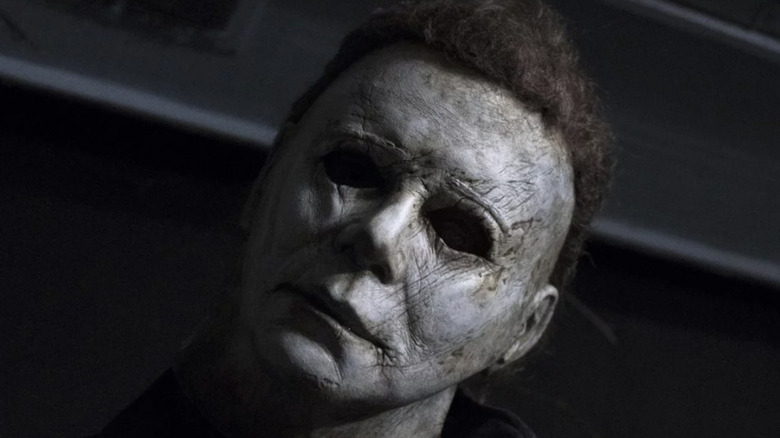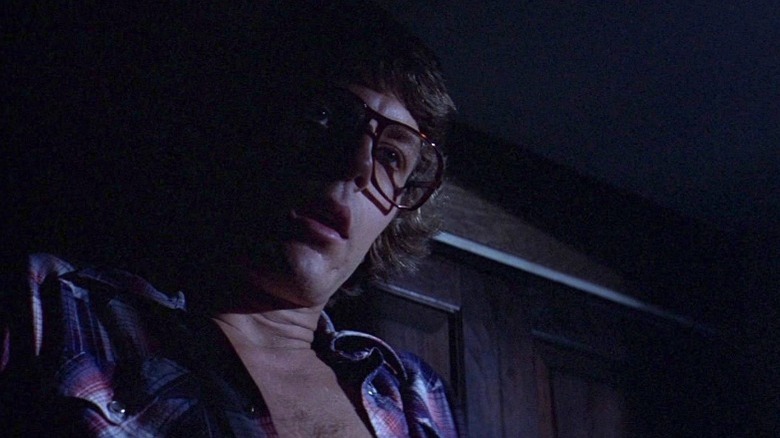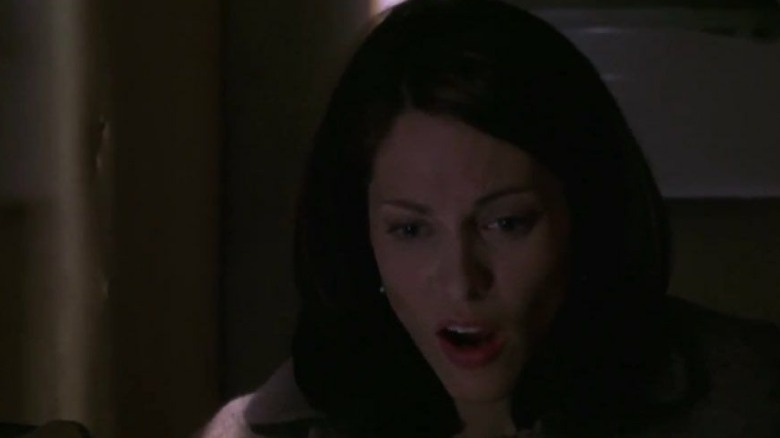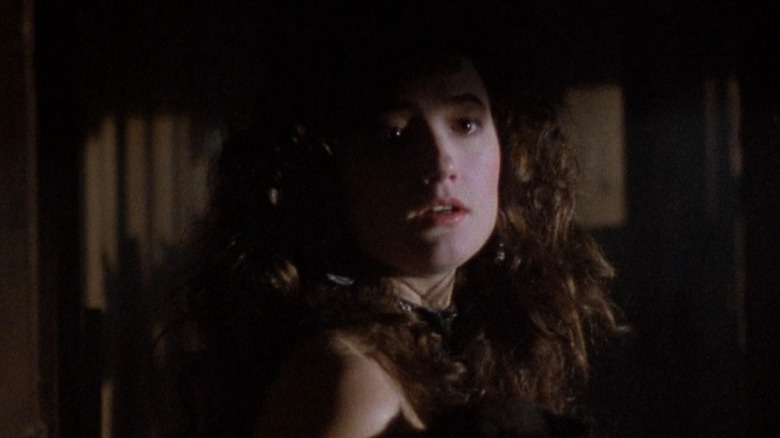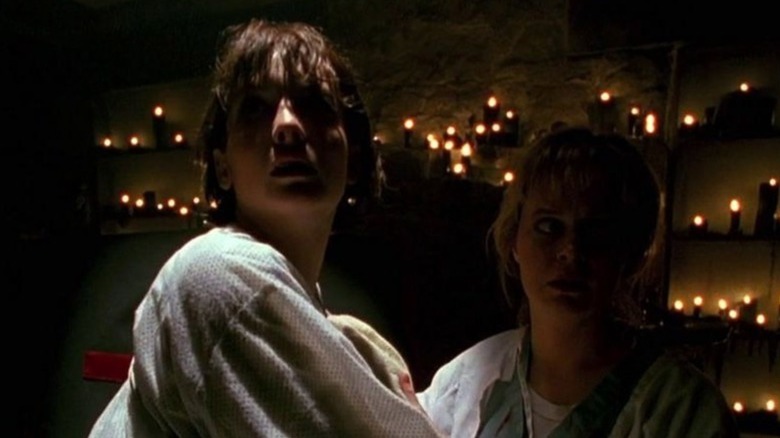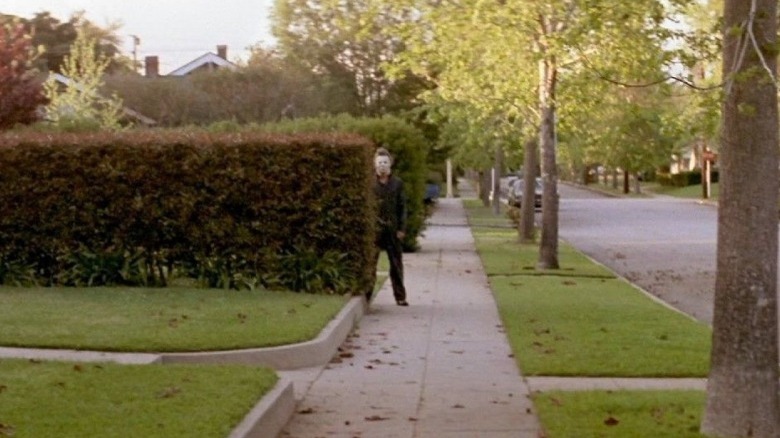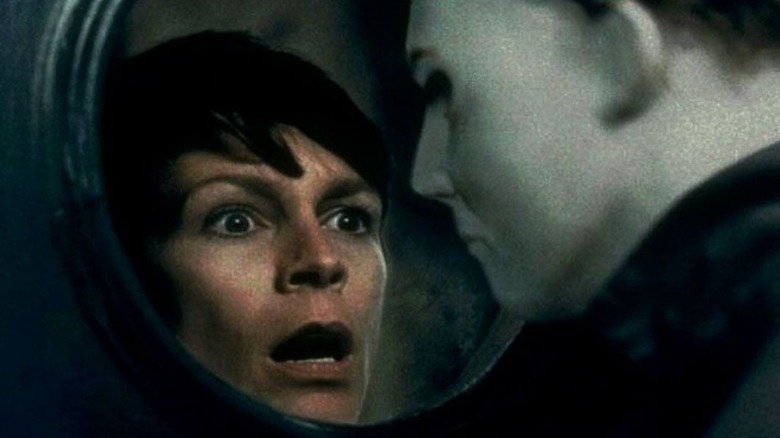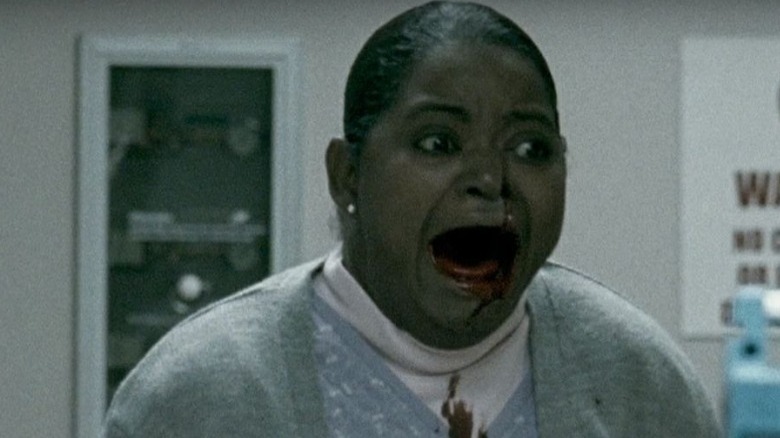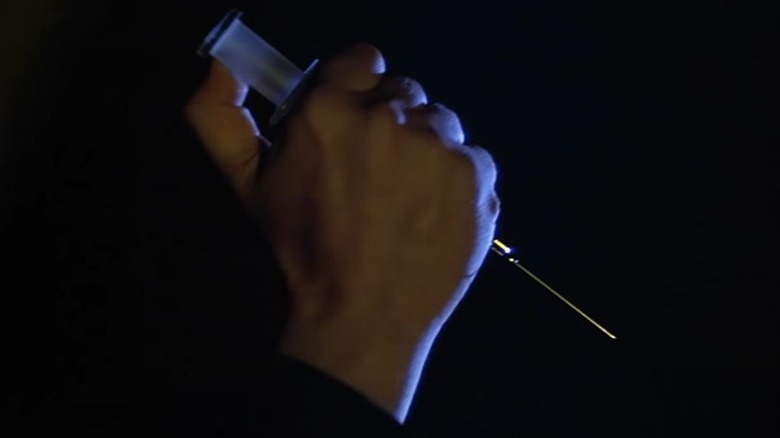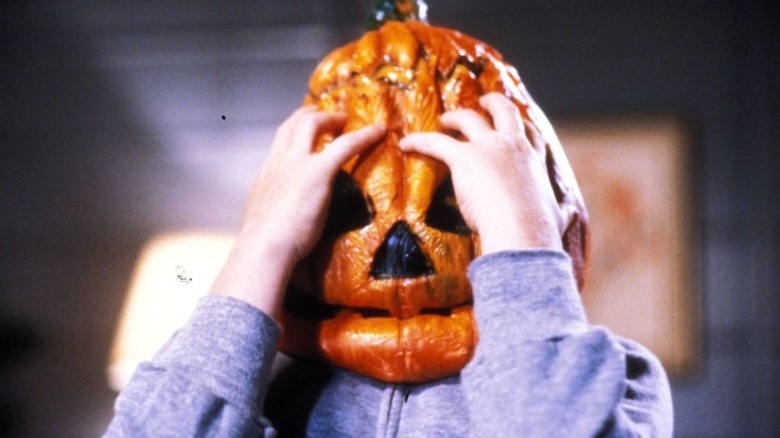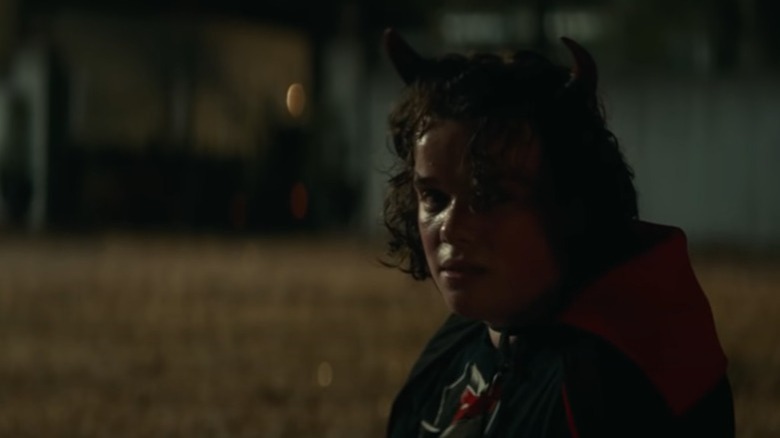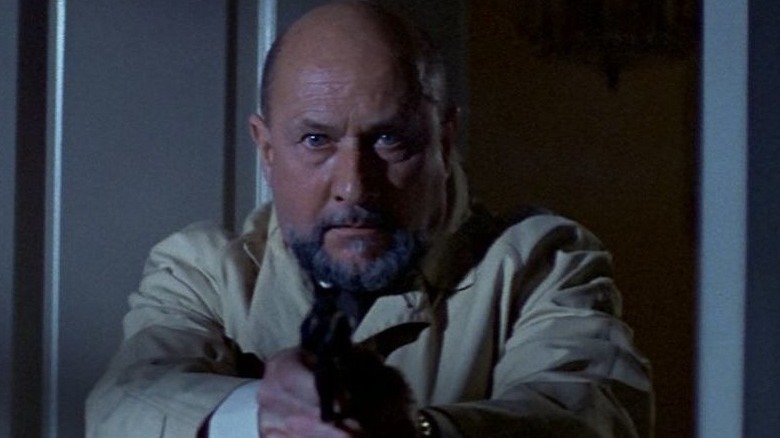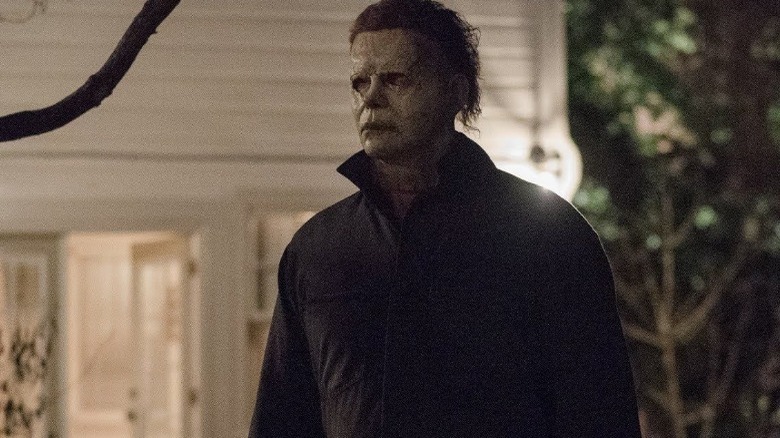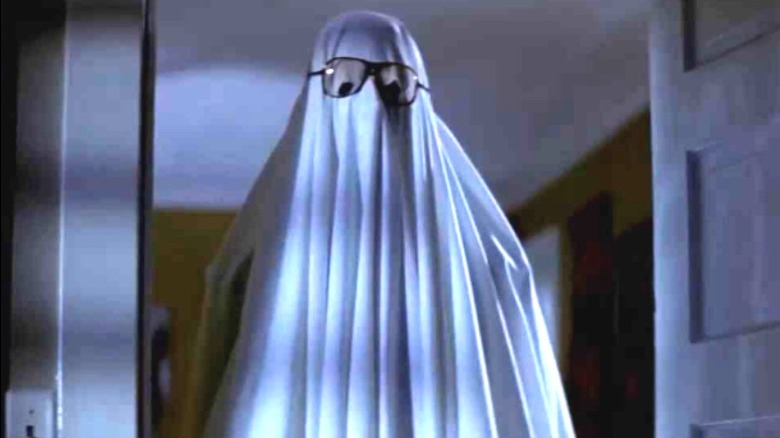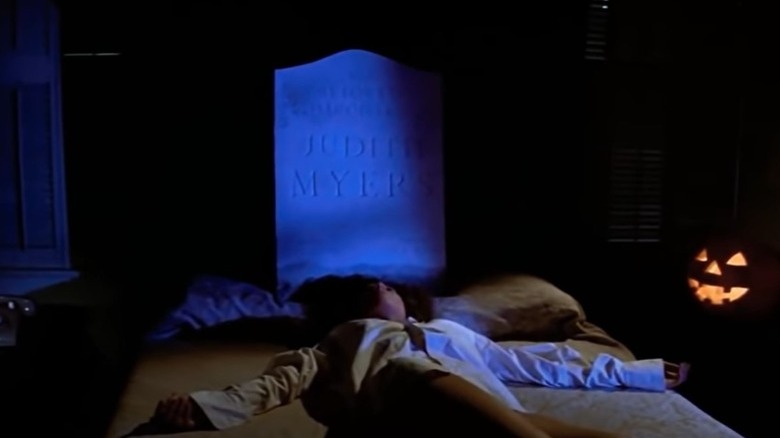Scariest Moments In The Halloween Franchise Ranked
Murderous stalkers have struck fear in the hearts of society since ... well, since the dawning of the concept of society. As some of the most notorious serial killers were still at large (from Jack the Ripper to the Son of Sam), communities would hunker down in terror, in dire hope law enforcement could stop the threat. It's a universally-understood fear, so it's no surprise that films from Fritz Lang's "M" to Alfred Hitchcock's "Psycho" linked that fear to the cinema, setting the stage for a modern boogeyman in a William Shatner mask.
John Carpenter's "Halloween" burst onto the scene in 1978 and became one of the highest-grossing flicks of the year, setting a record for the most successful indie horror film ever made — at last count, it had made its money back over 200 times. "Halloween" also signaled a new horror subgenre now known as the "slasher" film. The term "slasher" refers not only to the bladed weapons of monsters like Michael Myers, Jason, Freddy and later Ghostface, but perhaps also the way they slash through ill-behaving teenagers as if they were mere shrub brush getting in their way. Somehow, audiences inevitably found themselves rooting for these charismatic killers — all while the cinema monsters themselves upped the ante by proving themselves to be unstoppable killing machines in one Roman-numeraled sequel after another.
Michael Myers has been the face of the "Halloween" franchise (with the exception of "Halloween III: Season of the Witch"), ever since he hacked his sister to death at the age of six. Throughout the series, he's racked up a massive body count, often shocking audiences simply by the visceral, animalistic brutality of his kills. Other times, it isn't the murder itself at the center of a moment of palpable terror, but the tension. With that said, here's a breakdown of the scariest moments in the "Halloween" franchise's bloody history.
14. Bob's death – Halloween (1978)
As "Scream" famously pointed out, "I'll be right back" is the phrase someone speaks in a horror film that signifies they won't be. "Halloween" may have invented that particular horror cliché with the death of Bob Simms (John Michael Graham), whose post-coital utterance of that phrase forecasted a dead man walking. Bob seemed like a good enough guy — cool glasses, a taste for the occasional brewski — but alas, Bob had about as much chance of making it through Halloween as a fun-sized Snickers bar.
Making a quick jaunt downstairs for some beer, the quiet, unsettling air in the room precluded the inevitable. As Bob looked around the room after seeing the back door creek open, he was greeted by Michael, primed and ready for an ambush. Shocked, confused and terrified, Bob struggled for his life, but with Michael's hand firmly around his throat Bob didn't make a peep. After strangling the teen, Michael pinned him to the wall with a kitchen knife. While Michael seemed to put Bob out of his misery quickly, leaving the world in a flurry of terror isn't exactly the best way to go.
13. Bathroom scene – Halloween H20
Michael doesn't always kill. There are rare moments when the crazed stalker leaves an innocent passerby alone, and sometimes that's just as scary. In this 1998 hit-and-miss franchise rekindler that brought Jamie Lee Curtis back into the fold, one such time occurred as he scared the tar out of a poor mother looking to find a restroom for her young daughter during a road trip.
After situating her daughter in a stall, the mother took a moment for herself in the stall next door. While the young girl delightfully hummed, a stranger abruptly stole the mother's purse sitting just under the stall door. As she peered through the crack in the stall, she saw a terrifying masked man leaving the bathroom with the purse. Too scared to run after her belongings, she waited a moment before running to her daughter as the girl screamed. Thankfully, the attacker was only a spider. As she exited the bathroom, she saw the contents of her purse strewn about and someone driving away in her car. The moment was enough to terrify any parent of young children into making sure they always stayed in the same stall — and far away from any places Michael Myers might frequent. Thankfully, the two walked away unscathed, despite losing their wheels.
12. Tina's Death – Halloween 5: The Revenge of Michael Myers
The mid-series "Halloween" movies were all about Michael's desire to hunt down whatever remained of his relatives, and the continued pursuit of his niece Jamie (Danielle Harris) fueled "Halloween 5: The Revenge of Michael Myers." At the end of the fourth film, Michael had ostensibly met his doom after being gunned down by lawn enforcement and falling into a mine shaft. But the fifth film brought the boogeyman back, and his relentless pursuit of Jamie (with whom he shared a psychic link, much to the dismay of Dr. Loomis) brought about the end of Rachel Carruthers (Ellie Cornell), a somewhat adoptive sister of the little girl. Michael then turned his sights on Rachel's friend Tina (Wendy Foxworth), who had similarly taken a liking to young Jamie and was desperate to protect her from Michael.
In a climactic moment, Michael chased down the young girl in a car. Tina also gave chase, trying to distract the killer and making him crash into a tree. For a moment, Jamie could breathe easy, thinking her uncle was finally dead. But come on, this is a Michael Myers movie, so he rose again, only to be stopped in his tracks by a heroic Tina, determined to stall the killer so that Jamie could escape.
Of course, in a "Halloween" film, the only way you can stall death is to trade your own — so naturally, Michael stabbed the teen to death, then disappeared into the woods. No good deed ever goes unpunished in the "Halloween" universe.
11. Jamie Lloyd's death - Halloween: The Curse of Michael Myers
By the time the sixth "Halloween" film rolled around, the Jamie Lloyd storyline had begun to grow some moss. After being the "survivor" of the previous two films, it seemed only right that she'd receive one of the most gruesome deaths in the series in 1995's "Halloween: The Curse of Michael Myers." But apparently that wasn't brutal enough, as the filmmakers first recast the role, deciding they didn't want to pay franchise vet Danielle Harris her going rate to send the character out with a familiar face attached.
In "Curse," we learn that Jamie (now played by JC Brandy) had been captive to a mysterious cult and gave birth to a son. As she fled with her child, in hopes of sparing him the horror of their family bloodline, it is revealed that Michael is under the influence of the cult, and they now have their sights set on Jamie's child.
Michael relentlessly pursued Jamie and her son following their escape, but ultimately, she was able get her son to safety before being cornered in a barn. The killer impaled her on a thresher as Jamie asserted that Michael would not have her child — causing the masked psychopath to turn on the thresher as a punctuation, tearing Jamie's torso apart. The grisly scene was elevated by the tension and anxiety of the chase, and punctuated with the death of a popular (albeit, usually different looking) protagonist in the series.
10. Michael stalking Laurie – Halloween (1978)
Bloodshed isn't the only thing that sparks terror in a solid horror film. Cultivating anticipation within the audience for the eventual horrors to come can be just as eerie and terrifying. In the case of an unstoppable murderer, stalking victims sends up red flags in those who are more survival-savvy than the seemingly dimwitted characters on screen. However, if characters were instantly engaging into fight-or-flight mode after seeing a creepy man in a white mask staring at them from across the street, we wouldn't end up with the bloody, mucky situations horror films strive for in the end.
In the early moments of "Halloween," Laurie Strode appeared to be the instant fascination of newly-freed psychopath Michael Myers. Observing her from the shadows of his abandoned childhood home, the sidewalk across the street from her school, and later in between clotheslines in her own yard, Michael made his presence known — but at the same time, hid himself just well enough to leave her unsure she had seen much of anything. While Laurie felt that something was off, she hesitated to alert anyone to the strange stalker. For audiences, the nerve-wracking image of that eerie white mask, peering out from behind the bushes would become nightmare fuel for generations.
9. Window scene – Halloween H20
The "Halloween" franchise has undergone multiple retcons and reboots. A significant one was "Halloween H20." Set twenty years later, the film erased the entire Jamie Lloyd arc that went from "Halloween 4" to "Halloween: The Curse of Michael Myers," picking up the narrative instead as a new sequel to "Halloween II." Jamie Lee Curtis returned as Laurie Strode, although she was now living under the alias of Keri Tate in California. As destiny would have it, Michael tracked her down, and the nightmare began all over again.
In one particularly harrowing "H20" moment, Laurie's son John (Josh Hartnett) and his girlfriend Molly Cartwell (Michelle Williams) were pursued by the masked killer and forced to seek safety within a Hillcrest Academy campus building where Laurie worked as headmistress. An outside gate led to a small patio and front door entrance to the building, and the couple managed to unlock the gate, but dropped the keys on the wrong side. Now trapped, the duo yelled for help, hoping someone inside the building would open the front door.
As Michael tried to reach them through the gate, Laurie opened the door and brought the couple into the building. Then, in a moment of serendipity, Laurie and Michael came face-to-face through the door window, for the first time in 20 years. It's a masked face she'd never forget – and neither could the audience.
8. Nurse Daniel's death - Halloween II (2009)
When Rob Zombie rebooted the "Halloween" franchise in 2007, the rock star/horror director attempted to expand the lore by showing audiences the life of Michael Myers before he was institutionalized for murder. In this version of the tale, Michael pursued Laurie (now played by Scout Taylor-Compton), who was his biological sister. While the film did conclude in a similar fashion to how Carpenter had ended the original, the film did take some substantial liberties along the way.
Zombie's sequel had one moment that was a callback to the original "Halloween II," in which Laurie went to the hospital — just as she had in the original 1978 film. In a dream sequence, Laurie found herself there just after the tragedy that occurred in the first film. Attempting to see her friend Annie (Danielle Harris), who had been badly injured by Michael, a nurse (played by Octavia Spencer) attempted to stop her visit. Suddenly, Michael approached the nurse from behind, stabbing her countless times in the back. The sounds of the killing were what sealed this particular moment, making it viciously real. The end result was one of the more horrifically gruesome deaths in the "Halloween" franchise.
7. Syringe Stabbing - Halloween II (1981)
Make no mistake — the "Halloween" films are very, very stabby. But perhaps no intrusion through the skin has been more repellant than a needle-aided murder in the hospital-set second film.
Of course, when Michael and Laurie found themselves playing hide-and-seek in Haddonfield Hospital, there were potential murder weapons to be found everywhere. There were also plenty of potential victims, from nurses and orderlies to patients. Putting those two variables together couldn't help but spell disaster for the good folks of Haddonfield.
If you have a phobia of needles, this "Halloween II" scene was like a worst nightmare come true. After Michael Myers had killed a doctor with syringe to the eye, he was discovered by a nurse, unaware that Michael was still present in the shadows of the room. Grabbing the young nurse, he plunged a syringe into her temple. Just thinking about the scene is enough to bring squirms of discomfort back allover again.
6. Magic Pumpkin – Halloween III: Season of the Witch
Michael Myers may have taken a back seat for "Halloween III: Season of the Witch," but this offbeat one shot intended to launch a horror anthology was no less terrifying — and in the decades since, has become a solid cult classic.
The flick tells the story of an evil businessman with ties to pagan rituals and witchcraft, producing Halloween masks intended to trigger the full-scale destruction of children watching a Halloween program at home. A jack-o-lantern, witch, and skeleton mask are featured prominently in the film.
In these masks, the scheming entrepreneur implanted microchips embedded with Stonehenge fragments that, when activated, kill the wearer of the mask and cause insects and snakes to emerge from their corpses. Sure, it's sort of silly, but it's also really creepy, and the film made for some great visuals around the Silver Shamrock masks and build-up to this takeover attempt being fully revealed.
In one particularly grisly death, Cochran (Dan O'Herlihy) subjected a child to a test of the product. After touring the facility, the wide-eyed Kupfer family was taken to a test room where Cochran demonstrated the power of his masks. A flashing TV image was the signal the mask needed to envelop the child's face, causing him to recoil and die — a horrifying moment not only for the audience, but imagine how the kid's family felt.
5. Motion sensors – Halloween (2018)
This franchise reboot, engineered by David Gordon Green and Danny McBride, retconned the series. In effectively eliminating everything except the original John Carpenter "Halloween" film, it went on to become the highest-grossing movie in the franchise — quite impressive indeed for a decades-old horror franchise's 11th movie. Eliminating such baggage as the plot point that Michael and Laurie were siblings, it was set 40 years later, with Laurie now a grandmother — as well as a survivalist who had been preparing for decades for the return of Michael Myers.
The most creative horror films maximize the use of their environment for potential terror and dread. This new "Halloween" harnessed its setting in a memorable sequence involving an ill-fated teen and some motion sensor lights.
Following a school dance, Laurie's granddaughter Allyson (Andi Matichak), found herself being escorted home by a close friend yearning to be more, Oscar (Drew Scheid). When Oscar drunkenly attempted to hit on her (simultaneously breaking the horror movie rules of being mean and horny), he found himself all alone in a backyard — or was he?
What followed was a masterful sequence involving light, darkness, and the space in-between. As motion sensors were triggered, Michael always remained just beyond their reach, giving Oscar the sense that something was playing with him.
Of course, this all led to the teen turning around to find Michael standing in front of him. On cue, the lights turned off again, due to the motionless stand-off — but after a few moments of desperation and panic, the lights turn on again as the slashing begins. Allyson returned just in time to find Oscar's corpse impaled on the gate — a sign that grandma's crazy old stories were very real.
4. The Loomis monologue – Halloween (1978)
Sometimes, all it takes is words. Words to paint a picture of a being to be feared.
While many of the scariest moments of the "Halloween" series are punctuated by jarring musical cues and screams, the iconic monologue delivered by Dr. Sam Loomis (Donald Pleasence) broke down his twisted relationship with Michael Myers, and set the stakes for the entire franchise. Typically, doctors are supposed to do everything in their power to help a patient. Here was one so fundamentally disturbed by what he had witnessed that he had become convinced the most ethical thing he could do for the sake of mankind was to put Michael Myers down.
"I met him, 15 years ago; I was told there was nothing left: no reason, no conscience, no understanding in even the most rudimentary sense of life or death, of good or evil, right or wrong," the trenchcoat-clad, desperate Dr. Loomis explained as the notes of John Carpenter's soundtrack punctuated every point. "I met this ... six-year-old child with this blank, pale, emotionless face, and ... the blackest eyes — the Devil's eyes. I spent eight years trying to reach him — and then another seven trying to keep him locked up. Because I realized that what was living behind that boy's eyes was purely and simply ... evil."
Explaining all this to a largely indifferent Sheriff Brackett, Loomis explained his history with foreboding, weary words. He was a desperate man at the end of his rope, and death was coming to this little town.
3. Halloween neighborhood murders – Halloween (2018)
Michael Myers makes skin crawl because of his wholly-terrifying approach, rooted in reality, even if he frequently is not. While it's easy for a viewer to swat supernatural terrors away due to disbelief, the notion that a psychopathic home invader could stalk people at random and subsequently murder them for no apparent reason is a horror hook that could be real. One horrifying reminder comes via a sequence in David Gordon Green's 2018 "Halloween" reboot, in which Michael began his All Hallows' Eve murder spree through the lens of a long, single camera take.
As dusk settled in and costumed kids and adults made their way into the streets for candy and festivities, a grim fate awaited several innocent bystanders. The camera follows Michael while moving from house to house, as he broke and entered with ease and quiet persistence. Brutally murdering the occupants without raising suspicion among the general populace outside, the high note of the scene came when Michael killed one poor woman and then walked out her front door, onto the next house without anyone noticing. The implication, that someone could go door-to-door murdering as easily as a child soliciting candy bars on Halloween night, resulted in a truly terrifying sequence.
2. Ghost Michael – Halloween (1978)
While everybody remembers Bob's fate in the original "Halloween" film as unfortunate, the fact that his "spirit" was employed to help murder his girlfriend Lynda (P.J. Soles) just seemed to make everything even more tragic. On Halloween night, we've all learned, Michael Myers takes no prisoners. But he also doesn't simply rush in for the kill. He has always seemed to savor the moments, frequently toying with his victims — especially in the first two films, where there was a sort of near-goofiness to his homicidal actions. Taken alongside his stalking, it all seems to imply that each of his murders are more of an experience for the killer than a simple, primal act.
After killing Bob, Michael headed upstairs to visit Lynda. But he was now disguised as a ghost, with a sheet over his head and Bob's glasses on his face, as if Michael knew that upon seeing such a sight she'd be tricked into believing it was her recently-dispatched lover.
It worked, because Lynda believed that Bob was messing with her — but as she joked around, the unsettling silence from "Bob" built all the tension the scene needed. Lynda, however, never seemed to question why Bob had seemingly gone mute — turning her back on the killer to make a phone call to Laurie. It would prove to be a fatal error in judgement, as Michael strangled her with the phone cord.
1. Judith Myers Gravestone scene - Halloween (1978)
After Lynda was strangled over the telephone with Laurie listening on the other end, she had to investigate. It's at this moment, a mere 15 minutes before the end of the film, that Laurie truly discovered the horrifying intentions of the mysterious stranger who had been stalking her.
Earlier in the film, we saw Dr. Loomis visiting Mt. Sinclair cemetery, where the gravekeeper was distraught to discover that the grave of Judith Myers — Michael's older sister, who he killed in the opening moments of the film — had been ransacked. Now, that stolen tombstone was not only inside the Wallace house, but it had been arranged into a de facto grave for the body of Laurie's friend Annie Brackett. Decades later, it remains one of the most iconic images of the entire "Halloween" franchise — and showed Laurie Strode that she was in for the fight of her life.
